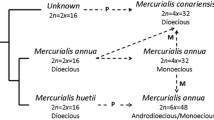Summary
1. Sex ratios of broods were studied in two lines of the woodlouse,Armadillidium vulgare. The two lines originated from two females, pregnant when collected from a wild population.
2. One line was found to breed true for amphogeny (1:1 sex ratios), and the other line bred almost true for thelygeny (nearly 100% females).
3. In the amphogenic line there was a small excess of females over males. Similar excesses of females are found in broods from amphogenic females of other woodlouse species.
4. Sex determination in woodlice, the origin of monogenic broods, and the inheritance of monogeny are discussed.
Similar content being viewed by others
References
Collinge, W. E. (1946). Hermaphroditism in a terrestrial Isopod.Nature, Lond.,157, 304.
Collinge, W. E. (1947). Further notes on the terrestrial Isopoda.Northwestern Naturalist,22, 84–87.
Goldschmidt, R. (1956). Theoretical Genetics. University of California Press, pp. 563.
Howard, H. W. (1940). The genetics ofArmadillidium vulgare Latr. I. A general survey of the problems.J. Genet.,40, 83–108.
Howard, H. W. (1942). The genetics ofArmadillidium vulgare Latr. II. Studies on the inheritance of monogeny and amphogeny.J. Genet.,44, 143–59.
Howard, H. W. (1953). The genetics ofArmadillidium vulgare Latr. III. Dominant and recessive genes for red body colour.J. Genet.,51, 259–69.
Lattin, G. De (1949). Ein Farbgen als relativer Geschlechts-realisator beiPorcellio seaber (Isopoda).Naturwiss.,36, 89.
Lattin, G. De (1951). Uber die Bestimmung und Vererbung des Geschlechts einiger Oniscoideen (Crust., Isopod). I. Mitt. Untersuchungen über die geschlechts-beeinflussende Wirkung von Farbfaktoren beiPorcellio undTricheoniscus.Z. indukt. Abstamm. u. Vererblehre,84, 1–37.
Lattin, G. De (1952). Uber die Bestimmung und Vererbung des Geschlechts einiger Oniscoideen (Crust., Isop). II. Mitt. Zur Vererbung der Monogenie vonCylisticus convexus (Deg.).Z. indukt. Abstamm. u. Vererblehre.,84, 536–67.
Magni, G. E. (1953). ‘Sex-ratio’, a non-Mendelian character inDrosophila bifasciata.Nature, Lond.,172, 81.
Rhoades, M. M. (1933). The cytoplasmic inheritance of male sterility inZea Mays.J. Genet.,27, 71–93.
Staiger, H. &Bocquet, C. (1954). Cytological demonstration of female heterogamety in Isopods.Experientia,10, 64–66.
Thompson, W. R. (1934). The tachinid parasites of woodlice.Parasitology,26, 378–448.
Vandel, A. (1938). Recherches sur la sexualité des Isopodes. III. Le déterminisme du sexe et de la monogénie chezTrichoniscus (Spiloniscus) provisorius Racovitza.Bull. biol.,72, 147–86.
Vandel, A. (1941). Recherches sur la génétique et la sexualité des Isopodes terrestres. VI. Les phénoménes de monogénie chez les Oniscoides.Bull biol.,75, 316–63.
Vandel, A. (1947). Recherches sur la génétique et la sexualité des Isopodes terrestres. X. Etude des garnitures chromosomiques de quelques espèces d’Isopodes marins, dulcaquicoles et terrestres.Bull. biol.,81, 154–77.
Author information
Authors and Affiliations
Rights and permissions
About this article
Cite this article
Howard, H.W. The genetics of armadillidium vulgare latr. J Genet 56, 1–10 (1958). https://doi.org/10.1007/BF02984715
Received:
Issue Date:
DOI: https://doi.org/10.1007/BF02984715




